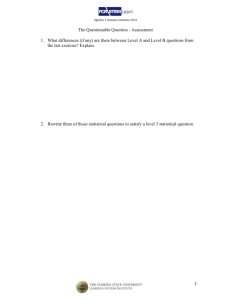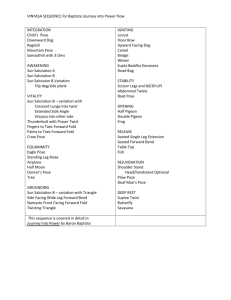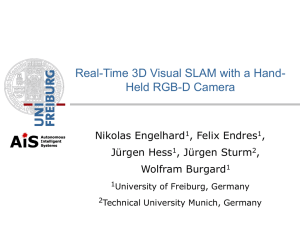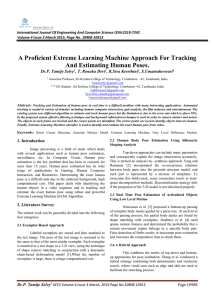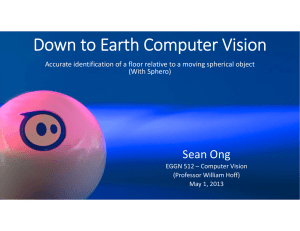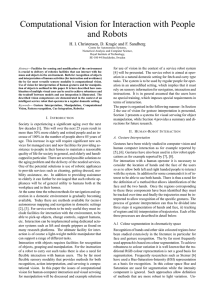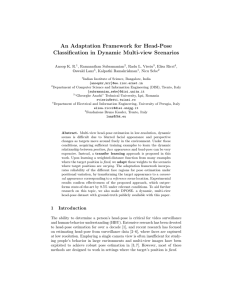FIDUCIAL ADEWOLE AYOADE ALEX YEARSLEY
advertisement
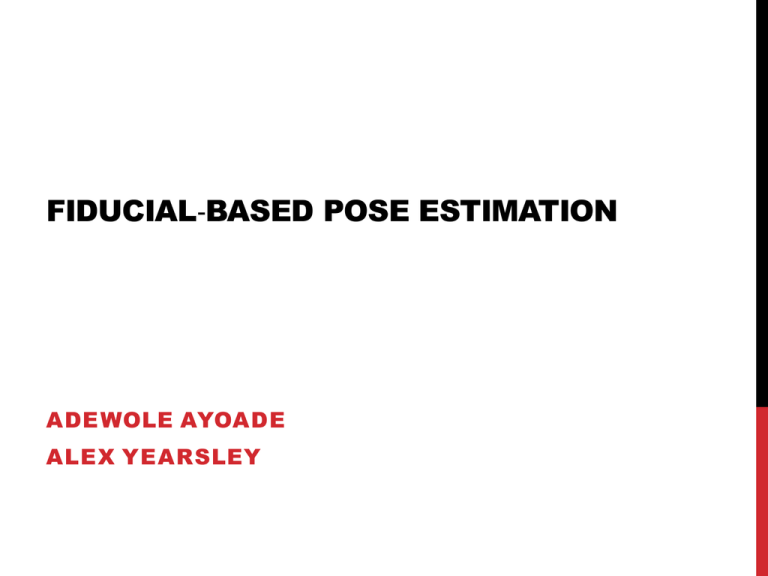
FIDUCIAL‐BASED POSE ESTIMATION ADEWOLE AYOADE ALEX YEARSLEY OVERVIEW Objective Motivation Previous Work Methods • Target Recognition • Target Identification • Pose Estimation Testing • Results Demonstration Conclusion – Future Work OBJECTIVE Provide visual based pose estimation to supplement GPS and dead-reckoning localization for an autonomous mobile robot in a oil refinery. MOTIVATION • Robot will be used to inspect processes in a refinery roughly the size of Golden • GPS has proven unreliable in industrial environments • Dead reckoning navigation is unreliable when travelling large distances • Supplement in identifying inspection locations as well PREVIOUS WORK: FIDUCIALS ARTookKit • Target detection: Binarization of input image • Decoding : correlation • Fast but not robust to change in illumination • Difficult to generate orthogonal templates ARToolkitplus • Digitally encoded payload ARTag • Detection mechanism based on image gradient • Robust to lighting and partial occlusion METHODS: TARGET RECOGNITION Locate concentric circles using morphological operations Code Outline 1. Convert image to grayscale 2. Threshold locally 3. Close the image with 5X5 disk 4. Perform blob analysis 5. Locate objects with the same centroids METHODS: TARGET IDENTIFICATION • Once the target has been located the target must be identified before it can be used to calculate pose • Each target is equipped with a pattern of black and white stripes • The pattern contains seven strips either black or white • Algorithm loosely based on QR code METHODS: TARGET IDENTIFICATION CONT. 1. Crop the “payload” out of the image 2. Locate the center of the payload 3. Move pixel by pixel to the across the image recording the number of pixels and their color 4. Identify changes from black to white (state changes) 5. Record the number of state changes and their corresponding pixel count 6. Normalize and compare with database METHODS: POSE ESTIMATION • A pose estimate is obtained using an iterative least squares approach to minimize the error E between pose estimate (x) and actual pose (y) E=|f(x)-y|^2 • The location of the target and the six concentric circles in the target are known • The robots current pose is then projected into the image frame • Compare the locations in the image frame • Update the pose estimate • The update is performed using the Jacobian of the projection function • Iterate until the convergence criteria is met RESULTS: TESTING SUCCESS RATE Target 1 Orientation 1 with occlusion Target 2 Orientation 1 Payload Target 1 Succes Finding Success Finding Target Payload Orientation 1 100% 100% 2 100% 50% 1 (w/ Occlussion) 90% 90% Target 2 Orientation 2 Target 2 Orientation 1 with occlusion Target 2 Succes Finding Success Finding Target Payload Orientation 1 90% 2 90% 1 (w/ Occlussion) 0% 90% 90% 0% RESULTS: TESTING ACCURACY Camera Orientation 1 Camera Orientation 2 Target 2 Orientation 2 Results • Camera orientation 1 – 0 deg to target plane • Camera orientation 2 - 30 deg to target plane • Maximum successful distance to target 13ft • Maximum angle to target plane 45 deg Target 1 Orientation Estimate X Estimate Y Estimate Z Error X Error Y Error Z 1 1.36 0.06 3.37 3.74 0.06 3.37 2 -11.15 -9.78 91.81 4.85 0.28 2.81 Target 2 Orientation Estimate X Estimate Y Estimate Z Error X Error Y Error Z 1 -4.85 -9.40 81.97 0.34 0.10 1.97 2 -10.70 -9.99 93.28 5.30 0.49 4.28 *All units are in inches CONCLUSION-FUTURE WORK • Visual based pose estimation can provide accurate real-time pose estimates • Occlusions are problematic for target finding and identification Future Work • Improve robustness of code • Enable code to search for missing targets • Allow code to handle a variable number of concentric circles (4 being the min) • Adapt to make use of three cameras and compute uncertainty in visual pose estimate • Combine with Kalman filter localization algorithm used on the robot currently

